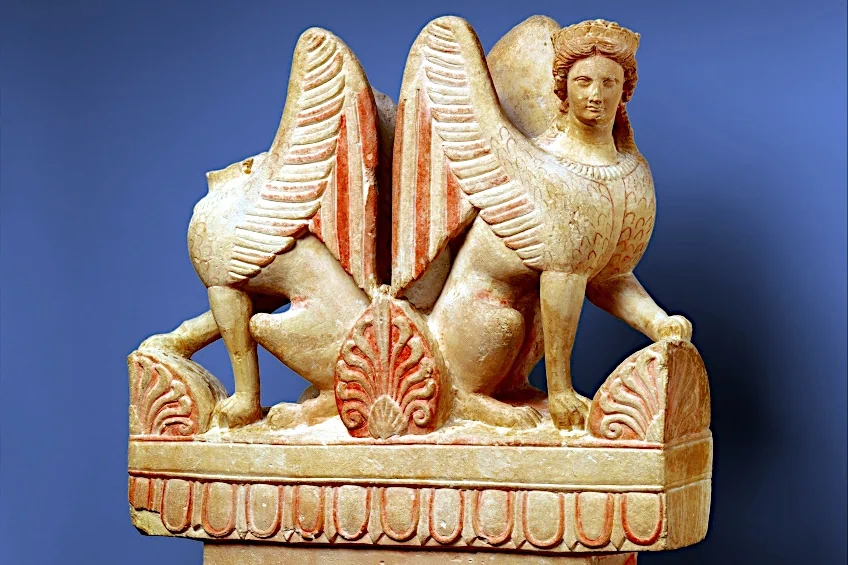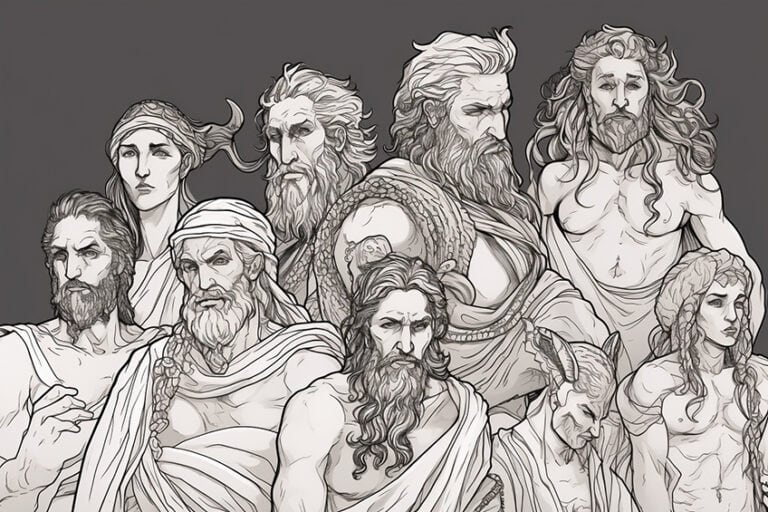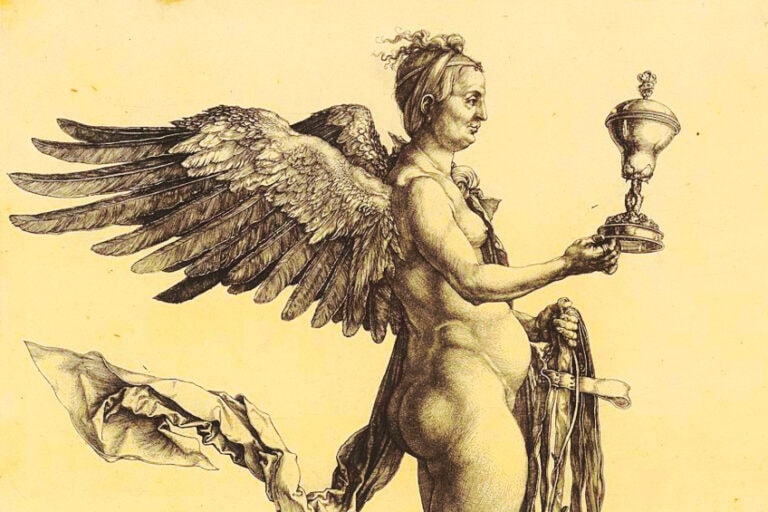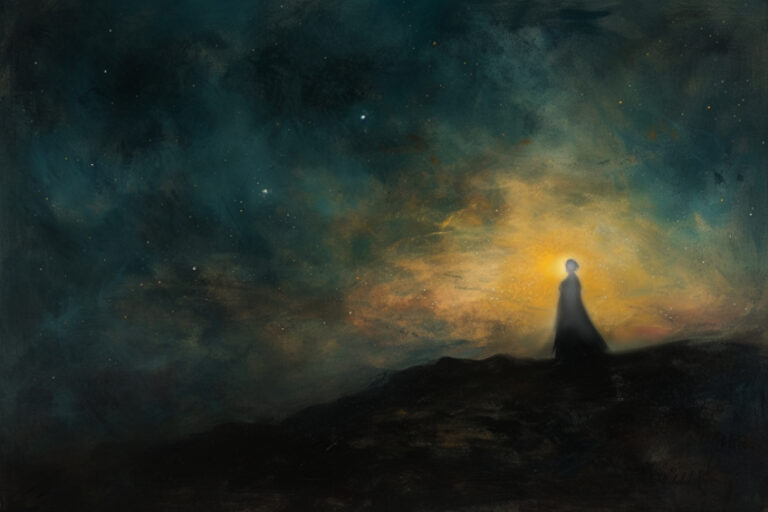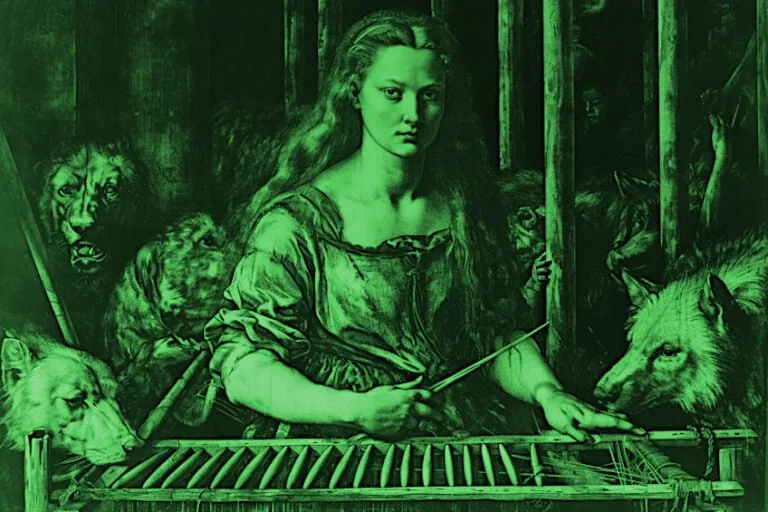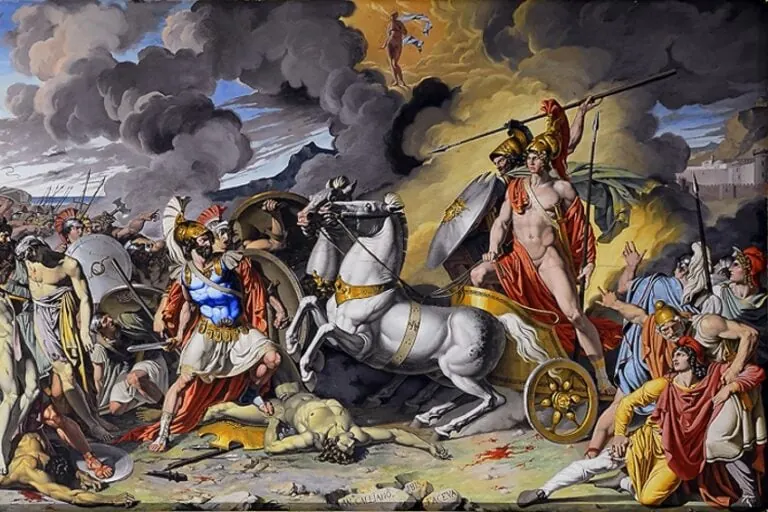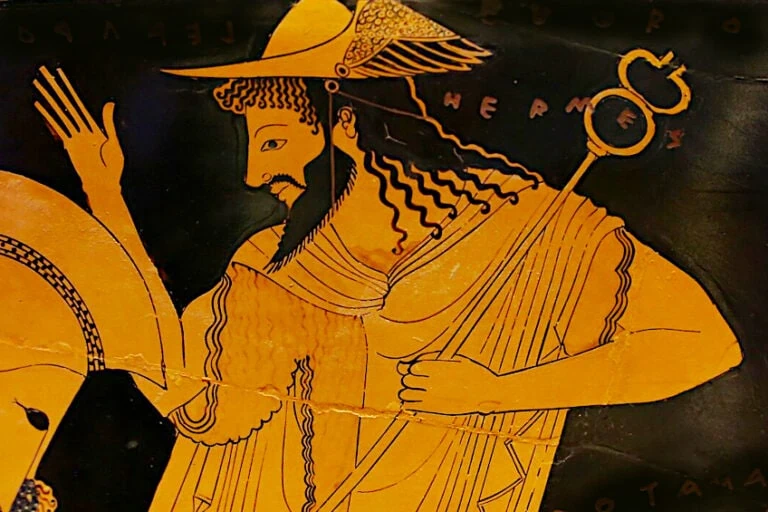Monsters in Greek Mythology – Creatures from Ancient Nightmares
We often hear about the famed gods and heroes of the ancient world, but what about the monsters in Greek mythology? There are many mythological legends about these Greek monsters and creatures and the roles they played in the lives of both gods and mortals. Below, we will explore these ancient Greek mythology creatures and examine their particular roles and stories.
Contents
Introducing the Greek Mythology Monsters
No story can have a hero if they do not face any particular challenges or obstacles, and it was usually the monsters in Greek mythology who served as the physical embodiments of these obstacles.
Some Greek mythology monsters were born from the gods themselves, while others were the result of curses.
Some Greek monsters were linked to certain creation stories, while others acted as manifestations of destruction. While they may not have technically been gods, they were, nonetheless, very potent and powerful entities that served as adversaries to mortals, gods, and heroes alike.
Greek Monsters in Early Greek Mythology
Greek monsters emerged early on in ancient Greek mythology. While not characterized as an actual monster, the mythological character of Chaos was believed to be a formless abyss of primordial confusion and disorder that existed before the universe came into being. Later, Gaia, who represents the Earth, and Uranus, who represents the sky, joined in union and gave birth to the Titans, the ancient gods and goddesses of Greek mythology. Some of the Titans were said to have monstrous physical features, such as Typhon.
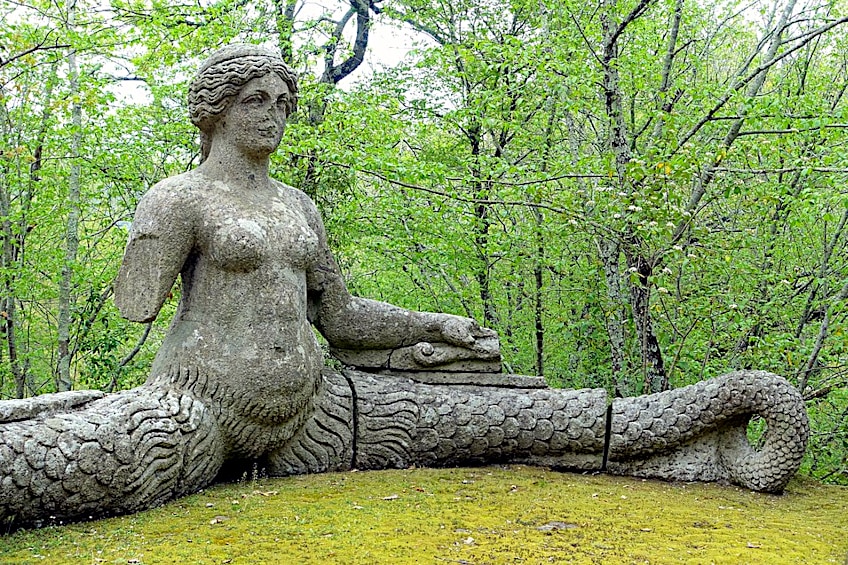 Sculpture of Echidna from the Gardens of Bomarzo or Park of the Monsters, Italy by Simone Moschino (16th Century); Daderot, Public domain, via Wikimedia Commons
Sculpture of Echidna from the Gardens of Bomarzo or Park of the Monsters, Italy by Simone Moschino (16th Century); Daderot, Public domain, via Wikimedia Commons
Echidna, a being that was half-serpent and half-woman, and Typhon then mated, which resulted in Echidna giving birth to many of the famous Greek mythology creatures, such as the Hydra, the Sphinx, the Chimera, and many more.
Due to her role in birthing so many prominent monsters in Greek mythology, she is referred to by many as the “Mother of All Greek Monsters”. Let’s begin by looking at these two important figures in the creation myths of these monsters.
Typhon
Seeing that his mate Echidna was known as being the mother of all the Greek mythology creatures, it should come as no surprise that Typhon was referred to as the father of the monsters of Greek mythology. Typhon was Gaia’s last child, but unlike the other Titans, his father was Tartarus, not Uranus. Typhon is regarded as one of the most potent of all the Greek mythology monsters. His presence was always accompanied by an immense storm, making it difficult to accurately determine his true shape.
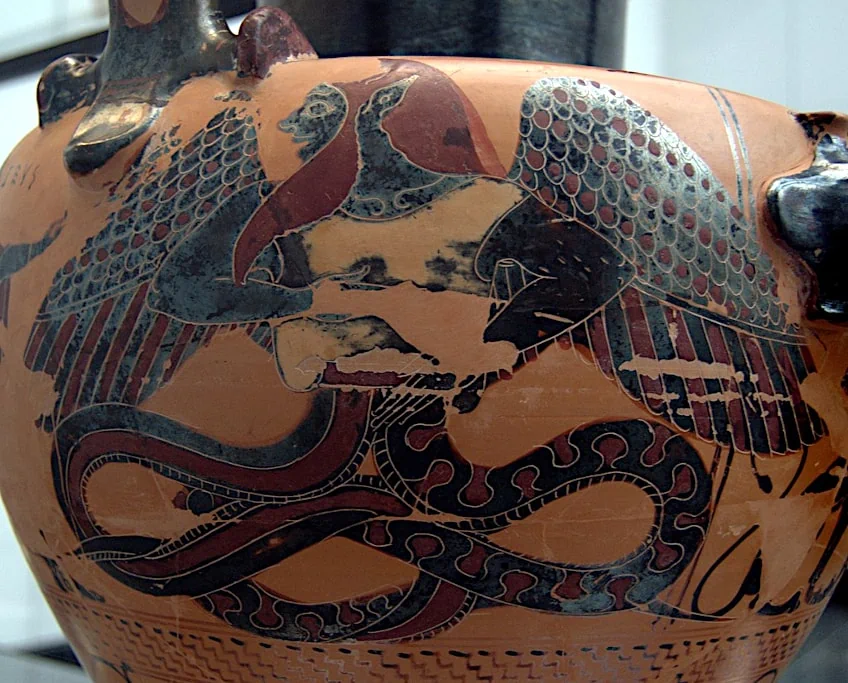 Chalcidian black-figure hydria with a depiction of Typhon (c. 550 BCE); Staatliche Antikensammlungen, Public domain, via Wikimedia Commons
Chalcidian black-figure hydria with a depiction of Typhon (c. 550 BCE); Staatliche Antikensammlungen, Public domain, via Wikimedia Commons
Some believe he had a human-like top half, while others say that Typhon had 100 dragon heads. His lower half was made up of massive snake coils. His wings were enormous, and fire blazed from his eyes. Typhon was a terrifying creature that even the Olympian gods and goddesses feared.
Typhon and his companion Echidna once even attacked the Olympians but were ultimately defeated. Zeus, the Olympian gods’ king, faced Typhon by hurling 100 lightning bolts at him and trapping him beneath Mount Etna in Sicily.
Echidna
Echidna was a combination of a snake and a winged woman with radiant eyes. She had the face of a gorgeous female and the physique of a serpent. She was immortal and dragged her prey to pits in the ground where she devoured them alive. Echidna lived in a cave deep below the Earth, and she birthed many legendary Greek mythology creatures with her partner, Typhon. Following their defeat by the Olympian gods and the exile of Typhon, Echidna, and her descendants continued to try to impede the voyages of future heroes in Greek mythology.
Echidna was a member of the Dracaena, which also included Scylla and Ceto, and were female Greek monsters that had the upper body of an attractive woman and the lower body of a dragon.
Greek Monsters in Hero Stories
Thanks to the union of Typhon and Echidna, the heroes in ancient Greek mythology were never short of adversaries and challenges during their adventures and quests. They were the parents of Scylla, the Nemean Lion, the Caucasian Eagle, the Sphinx, the Chimera, the Gorgon, the Cerberus, and many more. Let’s begin our look at these adversaries of Greek heroes with Cerberus.
Cerberus
Cerberus was the well-known three-headed hound that served as Hades, the god of the Underworld’s pet. Cerberus was stationed at the Gates of the Underworld, ensuring that no damned soul escaped and no living being entered the land of the dead. He possessed a snake for a tail in addition to his three scary heads.
 Painting of Cerberus from the Sidonian burial caves at Beit Guvrin (3rd Century BCE); dr. avishai teicher Pikiwiki Israel, CC BY 2.5, via Wikimedia Commons
Painting of Cerberus from the Sidonian burial caves at Beit Guvrin (3rd Century BCE); dr. avishai teicher Pikiwiki Israel, CC BY 2.5, via Wikimedia Commons
Only two Greek heroes, Orpheus and Heracles, were ever able to defeat Cerberus. Heracles defeated him with his physical power, while Orpheus lulled him to sleep with his singing. His parents were Typhon and Echidna, and he had a brother called Orthrus, who was a dog with two heads.
Chimera
The Chimera was a terrifying Greek mythological creature portrayed as a hideous hybrid with the head and body of a lion, a goat’s head growing from its back, and the tail of a snake. This Greek monster was famed for being able to breathe fire. The Chimera’s parentage varies in several different stories. The Chimera is considered to be the son of Typhon and Echidna in most accounts, although the sea deity Poseidon is said to be the Chimera’s father in others.
The Chimera was said to terrorize the Lycia area of Asia Minor. It would eat animals, communities, and even humans, wreaking havoc everywhere it went.
It was particularly deadly because of its flaming breath, which could scorch anything in its wake. The hero Bellerophon was entrusted with destroying the Chimera, who was accompanied by Pegasus. Bellerophon was able to ride Pegasus near the Chimera with the assistance of Athena and Poseidon. He fired arrows at the beast, evading its fiery breath, until he hit the Chimera in its most susceptible spot – its throat. Bellerophon eventually killed the Chimera, and he became highly renowned for having prevailed over this terrifying monster.
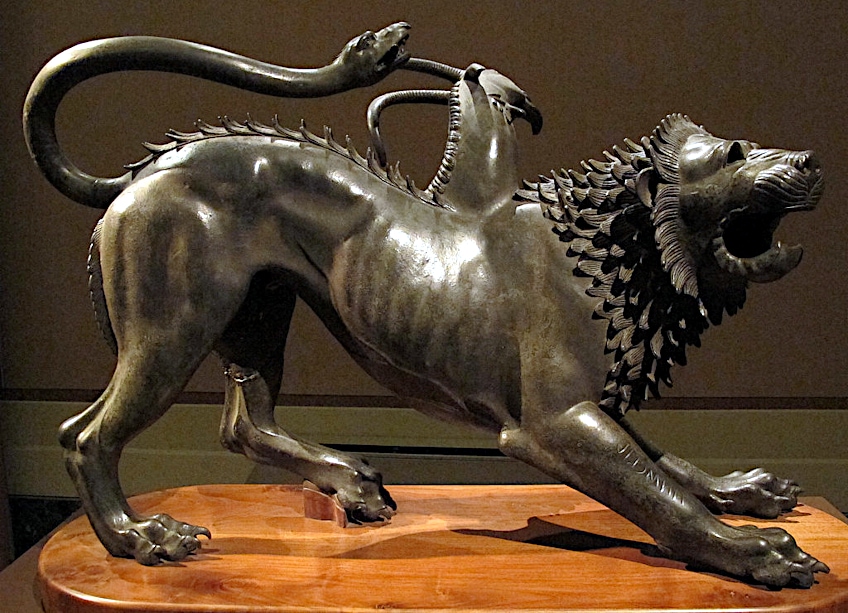 Etruscan bronze statue of a Chimera, also known as the Chimera of Arezzo (c. 400 BCE); I, Sailko, CC BY-SA 3.0, via Wikimedia Commons
Etruscan bronze statue of a Chimera, also known as the Chimera of Arezzo (c. 400 BCE); I, Sailko, CC BY-SA 3.0, via Wikimedia Commons
The Cyclopes
The Cyclopes were a mythical race of one-eyed giants in Greek mythology. The Cyclopes were excellent craftsmen famed for their metallurgical skills. They were thought to have created Zeus’ mighty thunderbolts. They were involved with the creation of divine weapons of the gods and other incredible items in various Greek myths.
The Cyclopes feature in a number of mythologies, often interacting with famous Greek heroes.
Odysseus, the Greek hero, and his entourage met a Cyclops named Polyphemus in The Odyssey by Homer. Held prisoner by the Cyclops in his cave, Odysseus devised a plot to blind Polyphemus and escape. Polyphemus’ repeated calls for assistance were answered by his father Poseidon, who cursed Odysseus on his return voyage home.
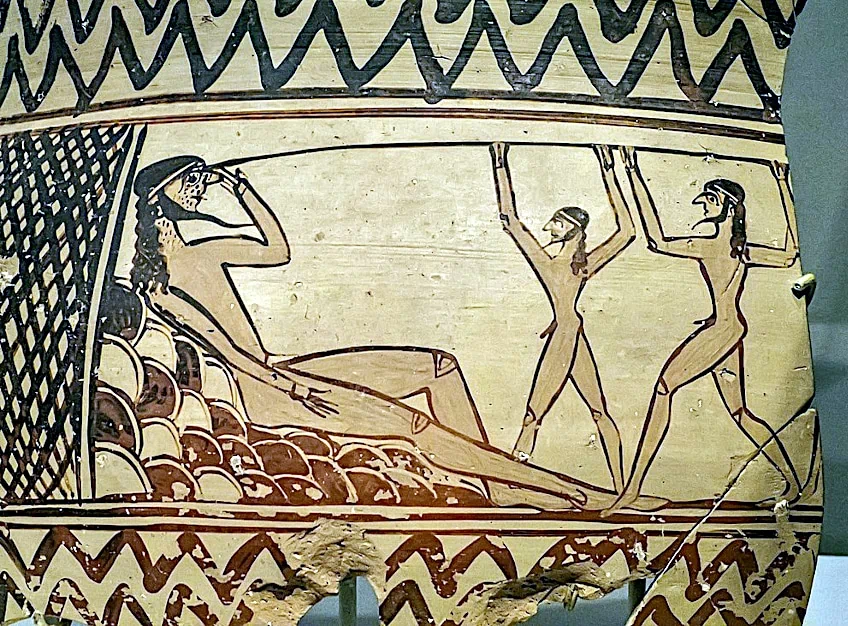 Archaic / Late Geometric krater with a depiction of Odysseus and crew member blinding the Cyclops Polyphemus (c. 670 BCE); Mary Harrsch, CC BY-SA 4.0, via Wikimedia Commons
Archaic / Late Geometric krater with a depiction of Odysseus and crew member blinding the Cyclops Polyphemus (c. 670 BCE); Mary Harrsch, CC BY-SA 4.0, via Wikimedia Commons
According to one story, the island of Lemnos was home to the deity Hephaestus, who was connected with blacksmithing and craftsmanship. The Cyclopes served as his aides in his forge, where they created remarkable objects together.
The Gorgons
The Gorgons were three terrifying sisters with hair composed of live, poisonous snakes and the ability to turn anybody into stone simply by glancing into their eyes. Euryale, Stheno, and Medusa were the famous Gorgon sisters. Medusa is unquestionably the most renowned and infamous of her kind.
 Etruscan-Corinthian kotyle with a depiction of a Gorgon by the Painter of the Bad Wolf (beginning of the 6th Century BCE); Carole Raddato from FRANKFURT, Germany, CC BY-SA 2.0, via Wikimedia Commons
Etruscan-Corinthian kotyle with a depiction of a Gorgon by the Painter of the Bad Wolf (beginning of the 6th Century BCE); Carole Raddato from FRANKFURT, Germany, CC BY-SA 2.0, via Wikimedia Commons
According to some tales, she was once an attractive priestess who served at the Temple of Athena rather than a terrifying Greek monster. Poseidon forced himself on her, and Athena punished her by transforming her into that hideous beast. Perseus, the Greek hero, murdered Medusa and used her severed head as a weapon for turning his opponents to stone.
Perseus subsequently gave Medusa’s head to Athena, who put it on her breastplate, known as the Aegis
The Harpies
The mythological Harpies were Greek monsters consisting of the head and upper torso of a woman and the talons and wings of a bird. They were portrayed as quick and dangerous beings. They were represented with ugly or decrepit appearances and wild hair. They were renowned for their agility, swooping down and seizing objects. The Harpies were known for taking food as a means of punishment or divine vengeance, especially from individuals or communities.
 Black-figure hydria with a depiction of a Harpy (530-500 BCE); Altes Museum, CC BY 3.0, via Wikimedia Commons
Black-figure hydria with a depiction of a Harpy (530-500 BCE); Altes Museum, CC BY 3.0, via Wikimedia Commons
They’d swoop down and steal food, leaving famine and desolation in their wake. The Harpies were dispatched by the gods as weapons of vengeance in various legends. The Harpies are mentioned most prominently in The Aeneid by Virgil. The Harpies were encountered by Aeneas and his fellow travelers on their voyage in this story.
The Harpies were connected to the dreaded Strophades Islands, and they spelled disaster for Aeneas and his followers.
The Sphinx
Another of the famous monsters in Greek mythology was the Sphinx which had the body of a lion, bird’s wings, and a woman’s head. She was a cunning and vicious monster that murdered and consumed anyone who failed to solve her riddle. This dangerous sphinx occurs in the Greek legends and dramas of Oedipus. This Sphinx was stopping people on their way out of the city of Thebes and asking them to solve a riddle or she would devour them whole.
“Which animal has only one voice, yet begins the day four-footed, is two-footed at noon, and three-footed at dusk?” was the riddle that she posed to these people.
In Sophocles’ Greek tragedy drama, the fabled King Oedipus was the only person who could answer the riddle and eventually killed the monster. He replied, “The answer is man – as he crawls on all fours as a baby, as a grownup he walks on two legs, and then requires a walking stick in his old age, the third foot”.
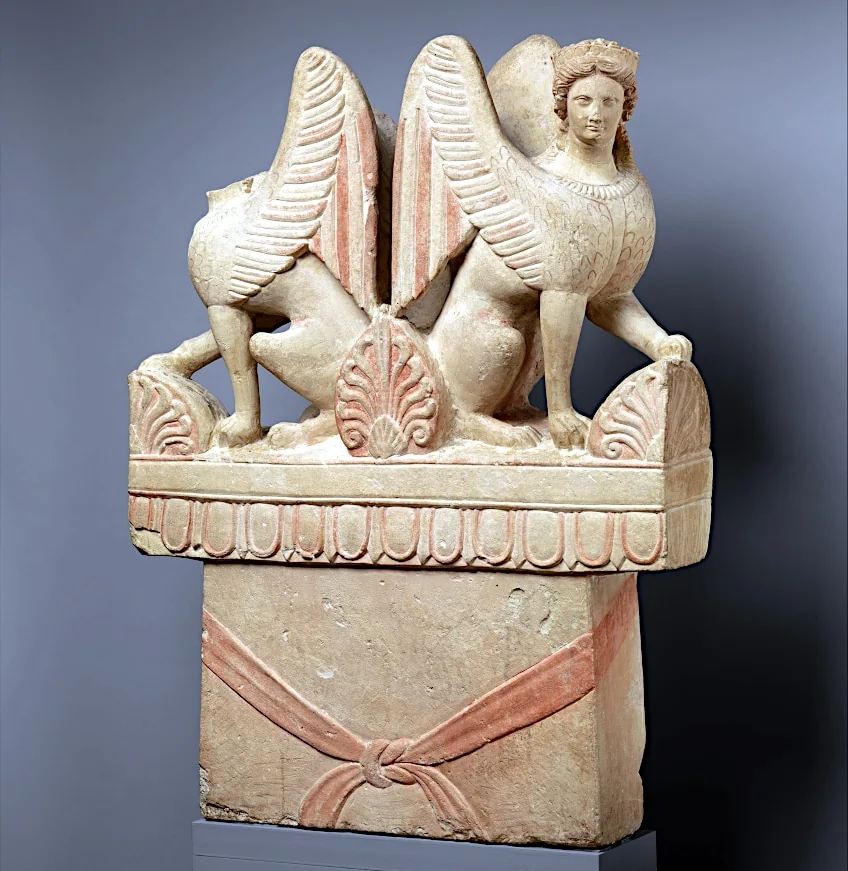 Funerary stele surmounted by two sphinxes (late 5th Century BCE); Metropolitan Museum of Art, CC0, via Wikimedia Commons
Funerary stele surmounted by two sphinxes (late 5th Century BCE); Metropolitan Museum of Art, CC0, via Wikimedia Commons
The Hydra
In Greek mythology, the Hydra was a giant serpent-like creature with several heads, generally nine, though other versions specify more or fewer heads. One of the Hydra’s heads was immortal, while the others could be killed. However, if any of these heads were cut off, two more would sprout in its place. The Hydra’s blood was thought to be toxic poison, as was its breath.
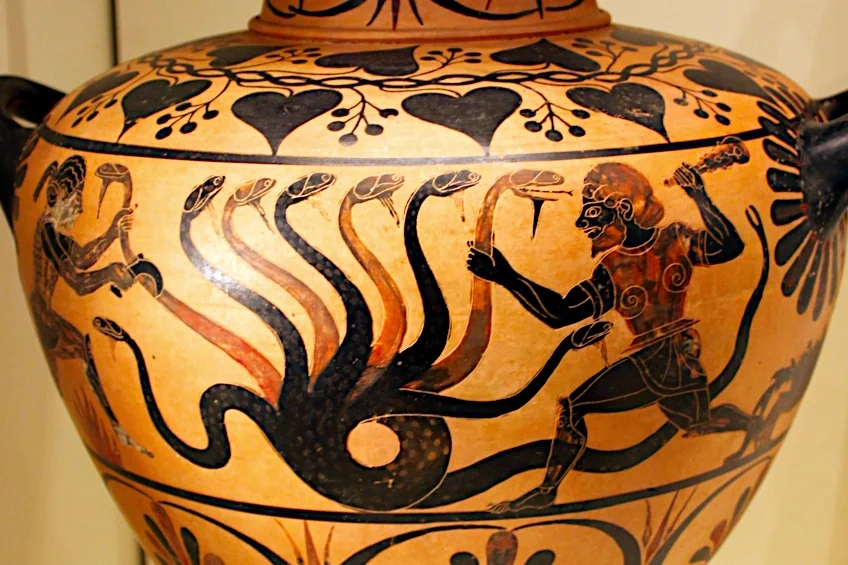 Etruscan hydria with a depiction of Herakles and the Hydra (c. 525 BCE); Gary Todd from Xinzheng, China, CC0, via Wikimedia Commons
Etruscan hydria with a depiction of Herakles and the Hydra (c. 525 BCE); Gary Todd from Xinzheng, China, CC0, via Wikimedia Commons
As one of his 12 labors, Hercules was assigned with slaying the Hydra. King Eurystheus, his cousin, sent him to slay the beast as a test of his power and courage. During the struggle, Hercules found that chopping off the Hydra’s heads was inadequate since they would regrow.
To accomplish this seemingly impossible task, he enlisted the help of his nephew Iolaus, who cauterized the stumps of the cut-off heads with fire while Hercules attacked the Hydra, effectively preventing them from regenerating.
The Minotaur
Poseidon created the Minotaur to exact retribution on King Minos of Crete for his act of disobedience in refusing to sacrifice a beautiful white bull. The deity caused Minos’ wife, Pasiphae, to fall in love with and mate with the white bull. A monstrous child was produced from this union. A creature with the appearance of a man but the power of a bull.
King Minos, unable to destroy the creature without further offending Poseidon, constructed a massive labyrinth in his palace’s basement.
The vast labyrinth, created by Daedalus, functioned as a prison for the mythical beast. In ancient Greek mythology, Theseus, the famous Greek hero, entered the labyrinth and killed the Minotaur.
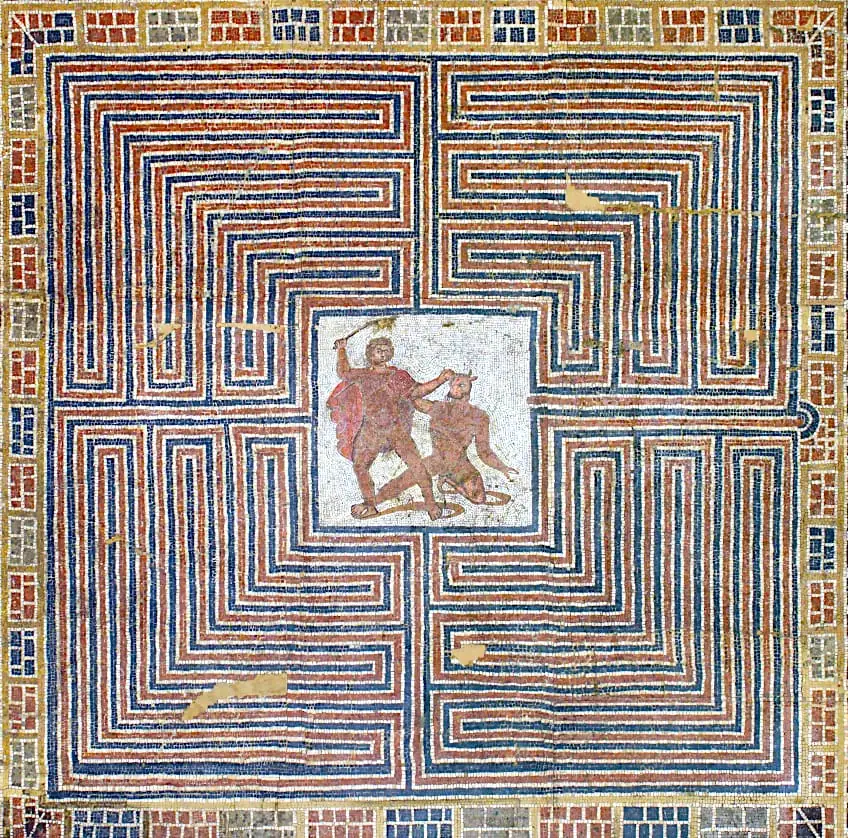 Mosaic depicting Theseus killing the Minotaur at the center of the labyrinth (300-400 CE); Kunsthistorisches Museum, Public domain, via Wikimedia Commons
Mosaic depicting Theseus killing the Minotaur at the center of the labyrinth (300-400 CE); Kunsthistorisches Museum, Public domain, via Wikimedia Commons
The Python
Gaia created him from the muddy clay of the Deucalion Flood, which Zeus used to bring down the Golden Age. Python resided in a cave and guarded Gaia’s sanctuary. In some versions of the myth, Apollo, one of the Olympian gods killed Python and took over the Delphic oracle that the monster had guarded.
The high priestess of Apollo who received divine inspiration and delivered the god’s oracles was called the Pythia in remembrance of Python, original owner of the Delphic oracle.
In other versions of the myth, Apollo killed Python because the monster had threatened the god’s mother Leto.
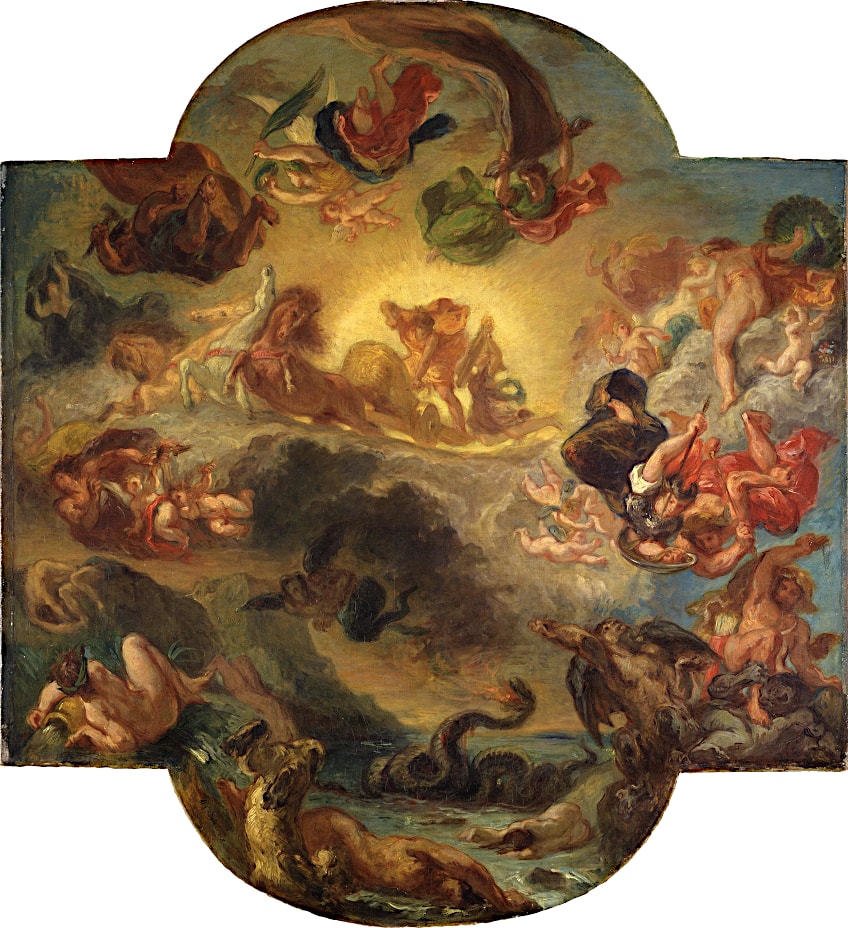 Apollo Slays Python by Eugene Delacroix (c. 1853); Eugène Delacroix, CC BY-SA 4.0, via Wikimedia Commons
Apollo Slays Python by Eugene Delacroix (c. 1853); Eugène Delacroix, CC BY-SA 4.0, via Wikimedia Commons
The Colchian Dragon
In Greek mythology, the Colchian dragon was an enormous fire-breathing snake who guarded the Golden Fleece, the revered prize that was sought by the Greek hero Jason and his Argonauts. Jason was able to defeat the guardian Greek monster and seize the Fleece with the assistance of the sorceress Medea. The witch put the dragon to sleep, and it was either left alone or murdered by the hero, depending on which version you read.
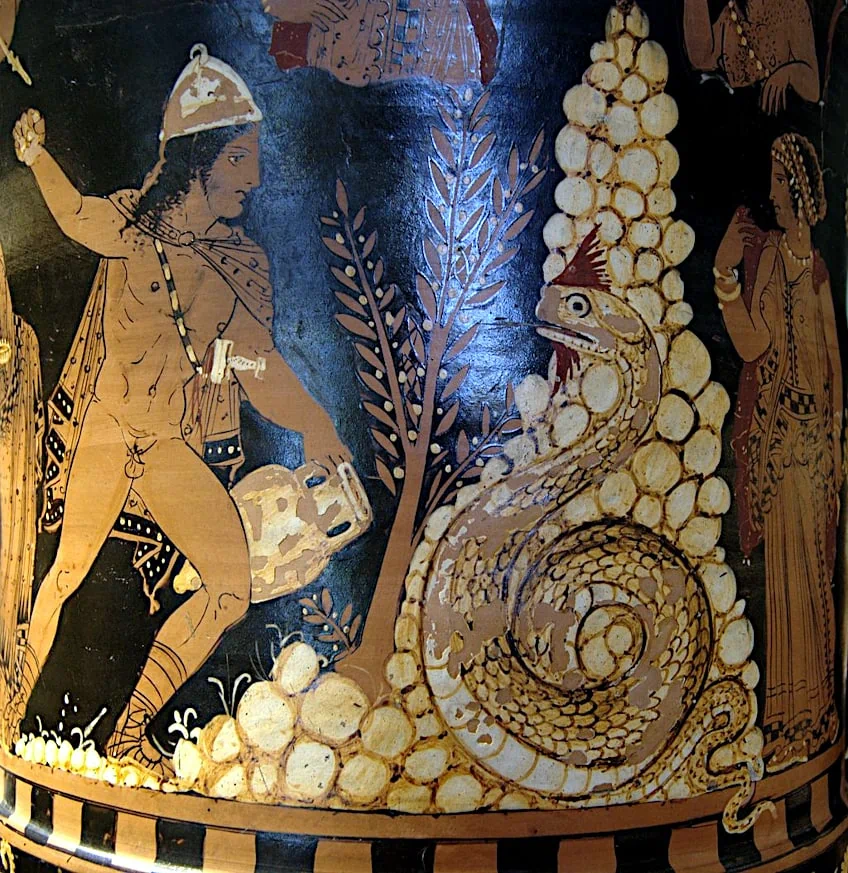 Red-figure kylix-crater with a depiction of Cadmus fighting the Dragon (c. 350-340 BCE); Louvre Museum, Public domain, via Wikimedia Commons
Red-figure kylix-crater with a depiction of Cadmus fighting the Dragon (c. 350-340 BCE); Louvre Museum, Public domain, via Wikimedia Commons
The Giants
The Giants were huge Greek monsters. They were human-like in appearance but enormous in size and power, according to Greek mythology. Their bodies looked very scaly, and they had lizard tails. They had long beards and very thick hair. Their hairy hands grasped long, gleaming javelins.
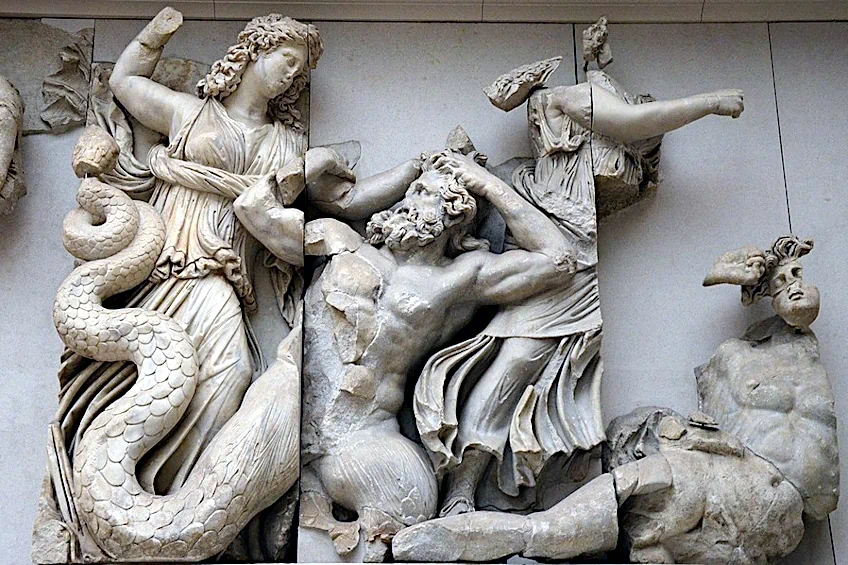 Scene from the frieze on the great Altar of Pergmanon depicting the Moirae killing the giants Thoas and Agrios (2nd Century BCE); Carole Raddato from FRANKFURT, Germany, CC BY-SA 2.0, via Wikimedia Commons
Scene from the frieze on the great Altar of Pergmanon depicting the Moirae killing the giants Thoas and Agrios (2nd Century BCE); Carole Raddato from FRANKFURT, Germany, CC BY-SA 2.0, via Wikimedia Commons
Despite their supernatural origins, they were actually mortal. According to some legends, the Giants lived forever as long as they remained on the land where they were born. They are thought to have superhuman abilities and long lifespans, yet they lack ethics and creative thinking.
Argus was a legendary Giant who served Hera by keeping watch over her love-rival Io so that Zeus could not visit her.
The Stymphalian Birds
In ancient Greek mythology, the Stymphalian Birds were man-eating monsters with bronze beaks, sharp metallic feathers that they could employ to attack their prey, as well as toxic feces.
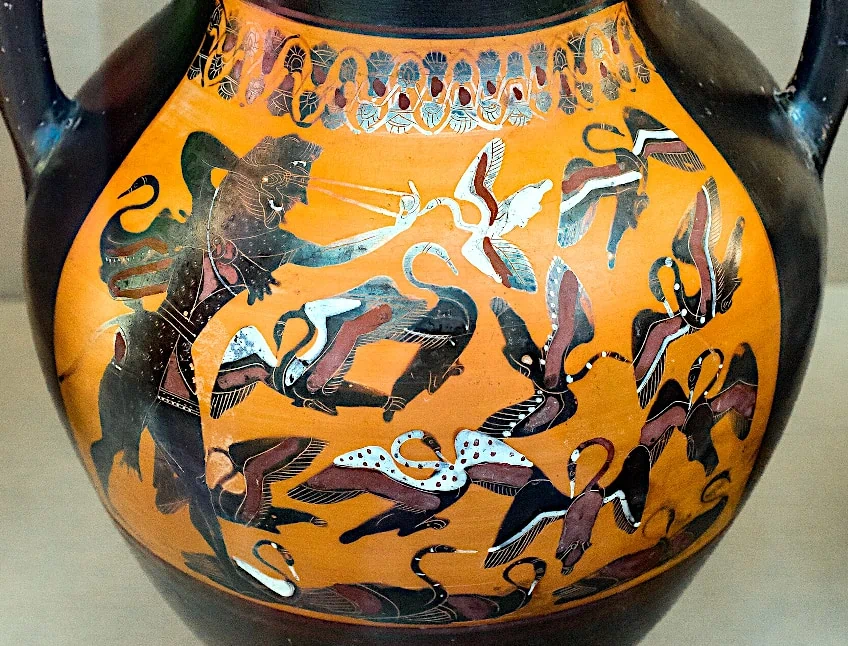 Attic black-figure belly-amphora with a depiction of Herakles killing the Stymphalian birds with a sling-shot (c. 540 BCE); ArchaiOptix, CC BY-SA 4.0, via Wikimedia Commons
Attic black-figure belly-amphora with a depiction of Herakles killing the Stymphalian birds with a sling-shot (c. 540 BCE); ArchaiOptix, CC BY-SA 4.0, via Wikimedia Commons
According to Greek mythology, these winged animals were either raised by the god of war, Ares, or were pets of Artemis, the goddess of hunting. They multiplied rapidly and swarmed throughout the countryside, destroying crops and terrifying the populace.
In his sixth labor, Heracles destroyed these animals by firing arrows laced with deadly blood from the slaughtered monster Hydra.
Greek Monsters in Tragedies
The existence of monsters in Greek tragedies often resulted in moral and ethical issues for the characters. They put the heroes’ values, actions, and choices to the test, pushing them to acknowledge their flaws or make tough decisions.
The Furies
The Furies, also known as the Eumenides and Erinyes, were autonomous deities who operated independently of the Olympian gods. They were tasked with punishing those who harmed members of their own families.
One well-known story featuring the Furies is their relentless pursuit of Orestes, the protagonist of Aeschylus’ tragedy Oresteia, who they drove mad.
When queen Clytemnestra murdered her husband Agamemnon, custom demanded that their son Orestes should avenge his father’s death. He killed his mother and her lover who had assisted her. The Furies chased Orestes ceaselessly, torturing him until he sought refuge at the altar of Apollo’s temple in Delphi.
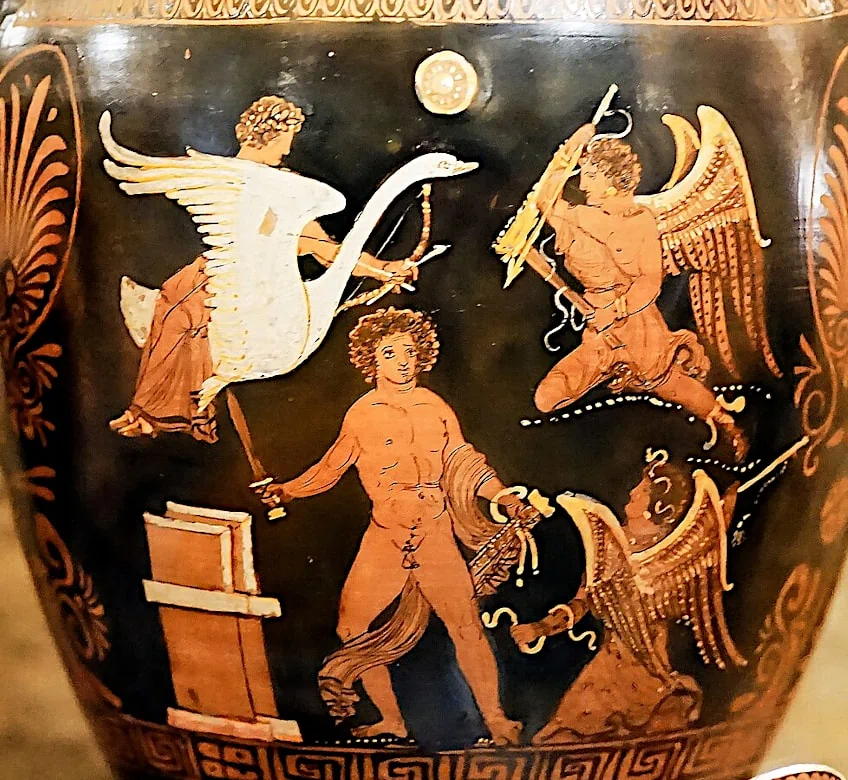 Apulian pottery with a depiction of Apollo protecting Orestes from the Furies (4th Century BCE); Fabrizio Garrisi, CC BY-SA 4.0, via Wikimedia Commons
Apulian pottery with a depiction of Apollo protecting Orestes from the Furies (4th Century BCE); Fabrizio Garrisi, CC BY-SA 4.0, via Wikimedia Commons
Orestes was finally taken to Athens to face trial. Athena eventually intervened, organizing a jury trial and changing the Furies into the Semnai (Venerable Ones), beneficent spirits of justice. The Furies represented an old type of justice based on vengeance and the preservation of cosmic order. They represented the endless quest for justice as well as the moral ramifications of one’s deeds.
Scylla
Scylla was the daughter of Kitos and Forky, and she was once a lovely Nymph whom the deity Poseidon desired. Poseidon’s envious lover, Amphitrite, transformed her into a monster by contaminating her bathing water.
 Bronze figurine of the sea monster Scylla (late 4th century BCE); Gre regiment, CC BY-SA 4.0, via Wikimedia Commons
Bronze figurine of the sea monster Scylla (late 4th century BCE); Gre regiment, CC BY-SA 4.0, via Wikimedia Commons
She has a fish-like body, a feminine upper torso, and dog heads emerging from her neck or waist. She roamed the rocks of a small strait near the whirlpool of Charybdis, another terrifying creature. In the Odyssey, Odysseus’ ship goes across the strait after losing six of his men to this terrifying Greek monster.
Charybdis
In ancient mythology, Charybdis is another fearsome female Greek monster. She is believed to be Gaia and Poseidon’s daughter. She resided on the Asian side of the Bosporus (a short natural waterway that serves as the continental barrier between Asia and Europe). Scylla lived on the European coast. Charybdis resembled a massive vortex with a gigantic mouth full of large, jagged fangs prepared to swallow any ship and men on board. Charybdis, like Scylla, is mentioned in the mythology of the Argonauts and Odysseus.
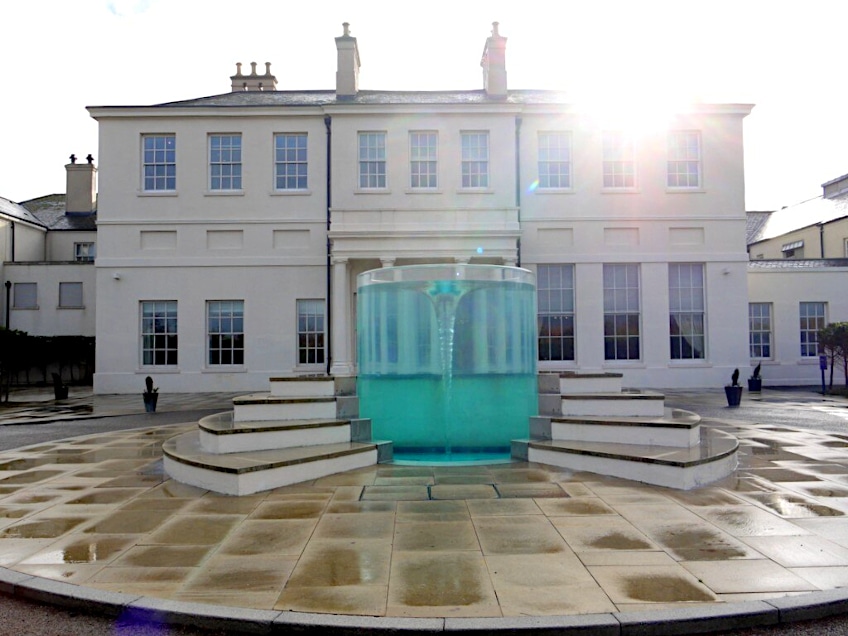 Charybdis by William Pye (2000); Andrew Curtis / Seaham Hall Hotel & ‘Charybdis’
Charybdis by William Pye (2000); Andrew Curtis / Seaham Hall Hotel & ‘Charybdis’
The Sirens
The Sirens were beings of temptation in Greek mythology, sometimes represented as part woman, part bird, with captivating voices. They lived on cliffs or rocky islands and enticed passing sailors with their alluring melodies, causing shipwrecks. The Sirens’ origins vary according to different versions of their mythology. These sirens were believed to be the daughters of Achelous, the river divinity, and Calliope.
Homer’s epic poem, the Odyssey, mentions one of the most popular interactions with the Sirens.
In the poem, Odysseus finds himself sailing past the Sirens’ island on his way home from the Trojan War. Odysseus, aware of the risk, instructs his men to seal their ears with wax in order to prevent themselves from being seduced by the Sirens’ singing. The Sirens are regarded as symbols of temptation and the repercussions of indulging in dangerous pleasures. Their songs symbolize the seductive nature of desire, which have the power to lead people astray from their goals.
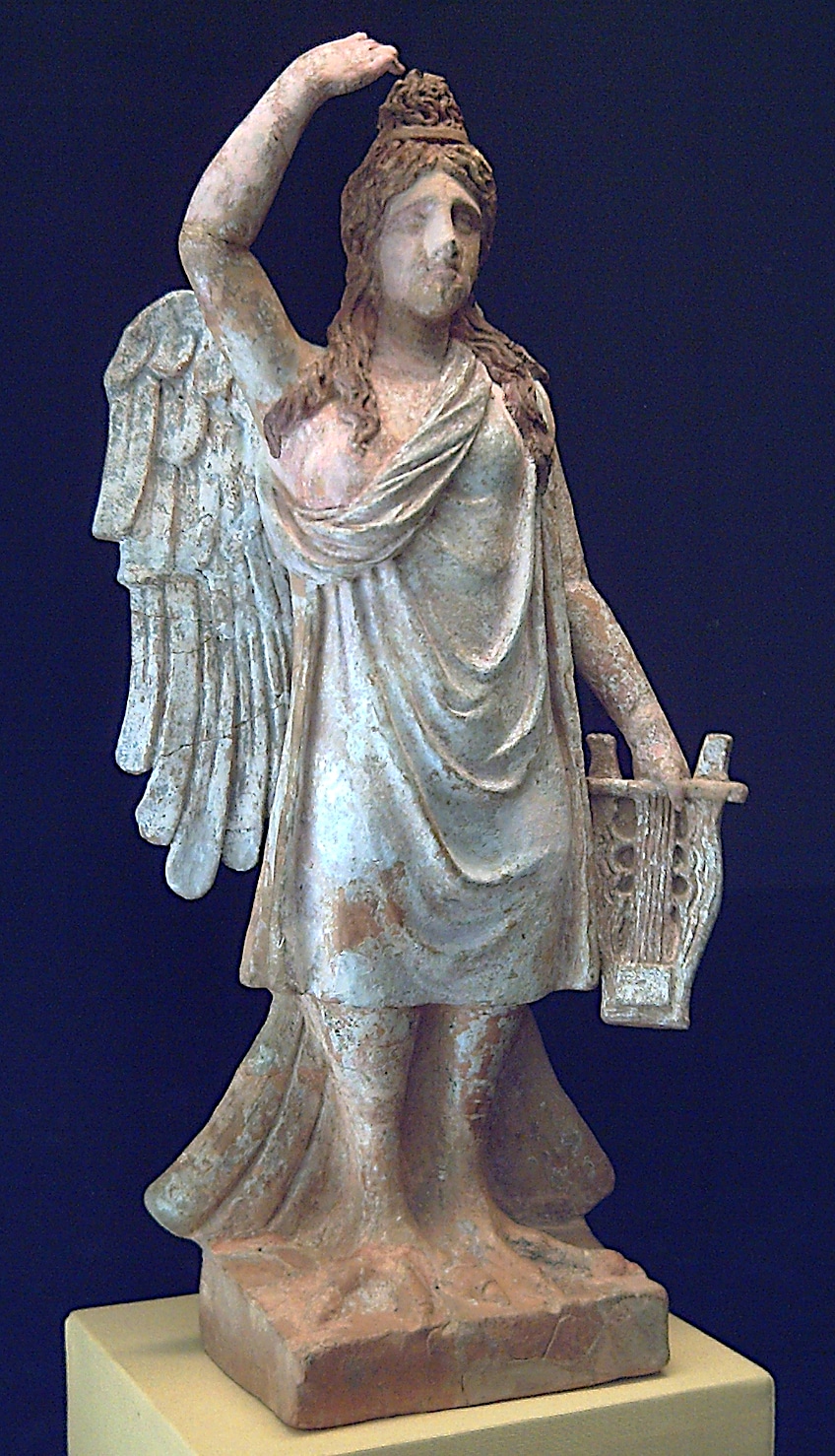 Polychrome terracotta statuette of a Siren (between 320 and 300 BCE); Luis García, CC BY-SA 3.0, via Wikimedia Commons
Polychrome terracotta statuette of a Siren (between 320 and 300 BCE); Luis García, CC BY-SA 3.0, via Wikimedia Commons
The Empusa
The Empusa was a type of shapeshifting beast from Greek mythology. While she typically appeared as an attractive woman, she was actually a violent creature that reputedly preyed on and devoured children and young men, similar to a Succubus. The Empusa has been described in many different ways. According to certain accounts, they can assume the appearance of monsters or desirable women. According to some stories, they had one leg made of bronze, copper, or an ass leg.
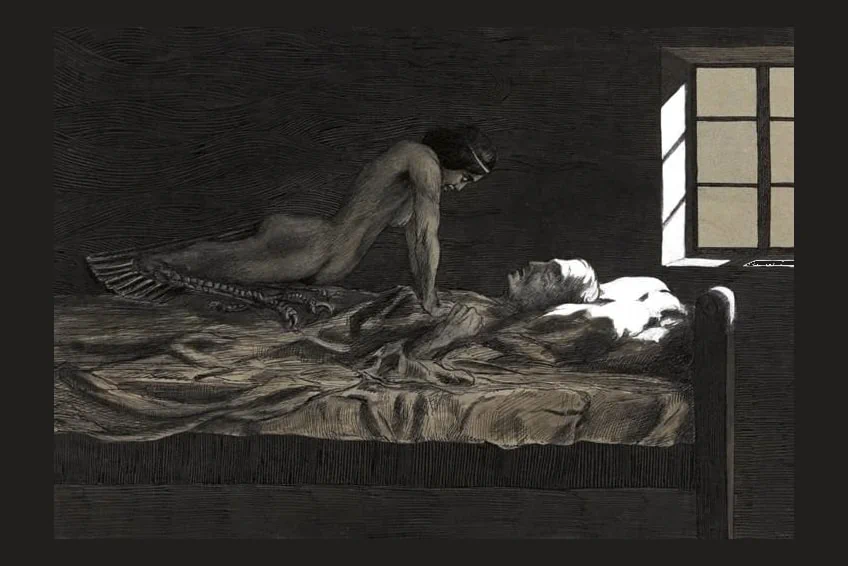 My Dream, My Bad Dream, by Fritz Schwimbeck (1915); Fritz Schwimbeck (1889–1972), Public domain, via Wikimedia Commons
My Dream, My Bad Dream, by Fritz Schwimbeck (1915); Fritz Schwimbeck (1889–1972), Public domain, via Wikimedia Commons
Aristophanes, the Greek comedian, relates that the Empusa had one leg made of cow dung alongside the metal leg for some strange reason. They also apparently had flames coiling out of their heads instead of hair. The Empusa was associated with the Greek goddess of witchcraft, Hecate.
According to some stories, the Empusai are Hecate’s daughters. But, like all other terrifying daemons of the night, they were ordered and obeyed her, whether they were actually her daughters or not.
Lamia
Zeus adored Lamia, an exquisite Libyan queen. As a result, through no mistakes of her own, Lamia attracted Hera’s wrath. Hera, enraged by Zeus’ attraction to her, offered no mercy to Lamia: each time the girl delivered a child, Hera would either murder it or force Lamia to kill it herself. Lamia eventually went insane and started stealing infants from other women just so she could devour them. Lamia’s vengeance is thought to have been so heinous that it permanently marred her face.
 Lamia by George Frampton (1899-1900); Nicola Quirico, CC BY-SA 4.0, via Wikimedia Commons
Lamia by George Frampton (1899-1900); Nicola Quirico, CC BY-SA 4.0, via Wikimedia Commons
This child-eating monster eventually became a bogey-woman, a term Greek mothers used to scare their young ones into obedience. To try to prevent Lamia from constantly devouring children, Zeus made her eyes detachable and forced Lamia to remove them and put them in a jar throughout the day, blind to everything surrounding her.
She’d then put her eyes back in at night and leave her cave to find her next victim.
Others claim that Zeus gave Lamia her detachable eyes in an attempt to assist her, as Hera had also cursed Lamia with insomnia, further tormenting the formerly attractive Libyan queen.
Ancient mythology from Greece is well-known for its myriad of Greek mythology monsters, which often emerge at critical points throughout Greek stories and epic poetry. These Greek mythology creatures are supernatural entities with distinct powers and skills that manifest themselves in various ways. The Greek Olympian gods used these peculiar and often terrifying monsters in Greek mythology. They could be sent for a variety of reasons, including to injure or destroy, protect, or induce fear.
Frequently Asked Questions
Why Were There Monsters in Greek Mythology?
Greek mythology monsters played many significant roles in the ancient tales of the gods and heroes of Greece. Some of them were created to protect, such as Cerberus, who was the guardian at the gates of the underworld. Other monsters were sent to challenge heroes on their paths, such as the embodiment of temptation, the Sirens. They were known for luring sailors to their death with their enticingly beautiful songs. Sometimes monsters served the gods, while other times they even caused trouble for them.
Where Did the Greek Mythology Creatures Come From?
Many of the Greek mythology monsters have unique origin stories and lineage. However, many of them were the offspring of Typhon and Echidna. The children of these two Greek monsters included the Sphinx, the Cerberus, the Chimera, the Hydra, and the Nemean Lion. Typhon and Echidna were said to be the offspring of Gaia and Uranus. However, even their lineage is disputed in various versions, with some versions claiming that Echidna was, in fact, the child of Ceto and Phorcys. Typhon and Echidna’s children would prove to be formidable adversaries for the heroes of ancient Greece.

I am deeply passionate about history and am constantly fascinated by the rich and complex stories of the past. As the editor-in-chief of learning-history.com, I have the opportunity to share this passion with a wide audience through the creation and distribution of engaging and informative content about historical events, persons, and cultures. Whether it’s through writing articles and blog posts or creating videos or podcasts, I strive to bring the past to life in a way that is both accurate and enjoyable. My expertise in history, combined with my strong writing and communication skills, allows me to effectively communicate complex historical concepts and make them accessible and interesting to a wide range of readers. I am truly grateful for the opportunity to share my love of history with others through my work on learning-history.com.

